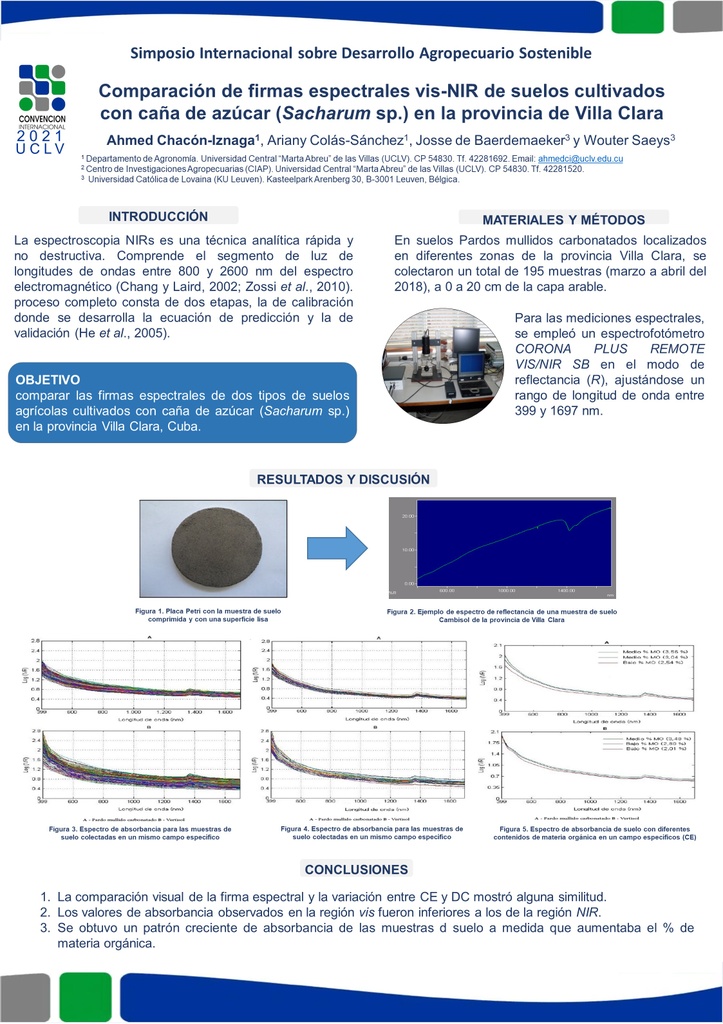Executive Secretary

10th International Scientific Conference on Agricultural Development and SustainabilityAGROCENTRO 2023
Agrocentro 2021

Abstract
The objective of this research was to compare the spectral signatures of two types of soils agricultural crops, Brown fluffy carbonated and Vertisol, grown with sugar cane in the province from Villa Clara, Cuba. Soil samples were collected at two levels: 1) different fields of the province (DC), 2) specific field (CE). Vis-NIR spectral signatures were acquired at the laboratory level with a portable spectrophotometer in the wavelength range of 399 to 1697 nm. The results showed that the absorbance spectra of these types of soils can be distinguished, suggesting that the soil type could be identified from the spectra obtained. The absorbance of light varied with the wavelength in each type of soil in DC and CE. A visual comparison of the shape of the spectra and the variation between DC and CE within the same soil type showed some similarity. Around 1400 nm in both types of soil, the absorbance values increased and then decreased. These characteristics demonstrate an excellent match between DC spectral signatures. And CE. In addition, in CE it was observed that the soil absorbance pattern increases in the same extent to which organic matter (MO%) increases. On soft brown soil carbonate this pattern was observed at 399 nm, while for Vertisol it was close to 580 nm.
Resumen
El objetivo de esta investigación fue comparar las firmas espectrales de dos tipos de suelos agrícolas, Pardo mullido carbonatado y Vertisol, cultivados con caña de azúcar en la provincia de Villa Clara, Cuba. Las muestras de suelo se colectaron en dos niveles: 1) diferentes campos de la provincia (DC), 2) campo específico (CE). Las firmas espectrales vis-NIR se adquirieron a nivel de laboratorio con un espectrofotómetro portátil en el rango de longitud de onda de 399 a 1697 nm. Los resultados mostraron que los espectros de absorbancia de estos tipos de suelos pueden distinguirse, lo que sugiere que el tipo de suelo podría identificarse a partir de los espectros obtenidos. La absorbancia de luz varió con la longitud de onda en cada tipo de suelo en DC y CE. Una comparación visual de la forma de los espectros y la variación entre DC y CE dentro del mismo tipo de suelo mostró alguna similitud. Alrededor de 1400 nm en ambos tipos de suelo, los valores de absorbancia aumentaron y disminuyeron seguidamente. Estas características demuestran una excelente coincidencia entre las firmas espectrales de DC y CE. Además, en CE se observó que el patrón de absorbancia del suelo aumenta en la misma medida en que se incrementa la materia orgánica (MO%). En suelo Pardo mullido carbonatado este patrón se observó a 399 nm, mientras que para Vertisol fue cerca de 580 nm.
About The Speaker

Dr. Ahmed Chacón Iznaga

Profesor Titular. Coordinador del programa de Doctorado en Ciencias Agrícolas. Vicedecano de Investigaciones, Postgrado e Internacionalización, Facultad de Ciencias Agropecuarias, UCLV
Discussion

